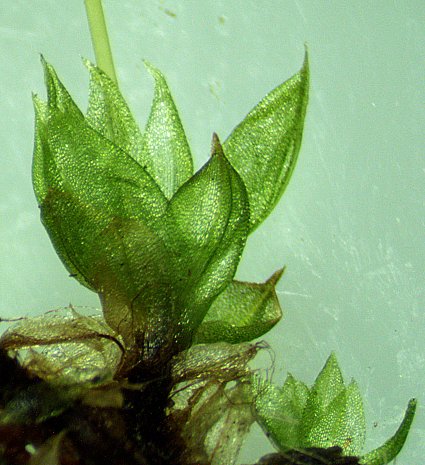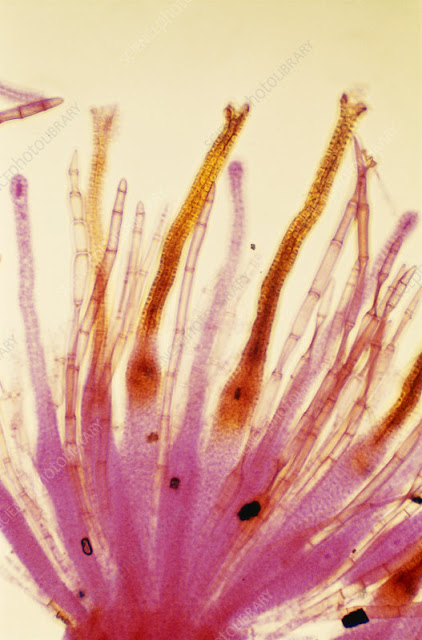Funaria: Morphological Features, Reproductive Strategies, and Ecological Significance of a Common Moss Genus
Habitat:
Funaria mosses are versatile in their
habitat preferences and can be found in a wide range of environments. They
commonly inhabit disturbed areas, including open fields, burned landscapes, and
areas with exposed soil. Their ability to colonize bare substrates and tolerate
a range of conditions allows them to thrive in both urban and natural settings.
Funaria mosses are also known to occur in forests, especially in areas with
high light levels.
Taxonomic Hierarchy:
The taxonomic classification of
Funaria can be outlined as follows:
- Kingdom:
Plantae
- Division:
Bryophyta
- Class:
Bryopsida
- Subclass:
Funariidae
- Order:
Funariales
- Family:
Funariaceae
- Genus:
Funaria
Within the genus Funaria, there are several species, each
with its own ecological preferences and characteristics. The taxonomic
hierarchy provides a systematic framework to understand the evolutionary
relationships and placement of Funaria mosses in the broader context of plant
diversity.
Gametophyte:
- Phyllids
(Leaves):
- The
gametophyte is the dominant and photosynthetic phase of the Funaria life
cycle.
- Phyllids
are leaf-like structures arranged spirally around the stem of the
gametophyte.
- These
leaves provide a large surface area for photosynthesis and are crucial
for the moss's ability to produce its own food.
- Stem:
- The
stem of the gametophyte is simple and lacks true vascular tissues found
in higher plants.
- It
provides structural support for the phyllids and contains cells for
water and nutrient absorption.
- Rhizoids:
- Rhizoids
are hair-like structures that extend from the base of the gametophyte
into the substrate.
- They
anchor the moss to the substrate and aid in water absorption. Unlike
true roots, rhizoids do not have specialized tissues for nutrient
uptake.
Reproductive Structures:
Antheridia (Male Reproductive
Organs):
·
Antheridia are umbrella-shaped structures found
on the tips of specialized branches on the male gametophyte of Funaria.
·
Each antheridium produces and releases motile
sperm cells. These sperm cells have flagella, allowing them to move through a
film of water to reach the female reproductive organs for fertilization.
·
Antheridia are essential for the production and
delivery of sperm to the vicinity of the archegonia during the process of
sexual reproduction.
Archegonia (Female Reproductive
Organs):
· Archegonia are flask-shaped structures located
on the female gametophyte of Funaria, typically at the tips of the main
branches.
·
Each archegonium contains an egg cell (or ovum)
in the lower part, which is the female gamete.
·
The neck of the archegonium provides a pathway
for the entry of sperm during fertilization.
·
Fertilization occurs when a sperm cell from an
antheridium swims through water and reaches the archegonium. The union of the
sperm and egg forms a diploid zygote within the archegonium.
Sporophyte:
- Development
from Zygote:
- Following
fertilization, the diploid zygote forms within the archegonium.
- The
zygote undergoes divisions and differentiations, eventually developing
into the multicellular sporophyte.
- Structure
of the Sporophyte:
- The
mature sporophyte consists of two main parts:
- Seta
(Stalk):
- The
seta is a slender, elongated structure that elevates the capsule above
the gametophyte.
- It
connects the capsule to the gametophyte and provides support for the
reproductive structures.
- Capsule:
- The
capsule is a protective structure at the tip of the seta.
- It
contains spore-producing cells and plays a crucial role in the
dispersal of spores.
- Capsule Structure and Spore Formation:
- The
capsule is often cylindrical or urn-shaped and has a lid known as the
operculum.
- Inside
the capsule, spore-producing cells undergo a process called sporogenesis,
resulting in the formation of haploid spores.
- These
spores are crucial for the continuation of the moss life cycle.
- Sporangium
and Peristome Teeth:
- The
spore-producing cells are organized within a structure called the
sporangium.
- The
peristome, a set of teeth surrounding the opening of the capsule, helps
regulate the release of spores.
- The
peristome aids in spore dispersal by responding to changes in humidity,
gradually exposing the spores to the external environment.
- Spore
Dispersal:
- When
conditions are suitable, the operculum at the top of the capsule opens,
and spores are released into the environment.
- Spores
are dispersed by various means such as wind, rain, or other external
factors.
- Germination
of Spores:
- When
a spore lands in a suitable environment, it germinates to form a
filamentous structure known as the protonema.
- The
protonema develops into the gametophyte, completing the life cycle and
initiating a new generation of Funaria.
The sporophyte of Funaria is a critical stage in the moss
life cycle, responsible for producing spores that enable the moss to colonize
new habitats. The unique features of the capsule and its mechanisms for spore
dispersal contribute to the success of Funaria as a pioneer species in various
ecosystems.
Frequently Asked Questions (FAQs):
- What
is Funaria?
- Funaria
is a genus of mosses, belonging to the Bryophyta division, known for its
distinctive life cycle and ecological significance.
- Where
is Funaria commonly found?
- Funaria
mosses are versatile and can be found globally in a variety of habitats,
including disturbed areas, open fields, burned landscapes, and forests.
- What
is the life cycle of Funaria?
- Funaria
exhibits an alternating life cycle with haploid gametophyte and diploid
sporophyte generations. Spores germinate to form protonema, which
develops into the mature gametophyte. Sexual reproduction occurs through
antheridia and archegonia, leading to the formation of a sporophyte.
- How
does Funaria reproduce?
- Funaria
reproduces both sexually and asexually. Sexual reproduction involves the
production of spores through fertilization of egg cells within
archegonia. Asexual reproduction can occur through fragmentation or the
growth of gemmae.
- What
are the distinctive features of Funaria's gametophyte?
- Funaria
gametophytes have leaf-like structures called phyllids arranged spirally
around the stem. Rhizoids anchor the plant and aid in water absorption.
- What
are antheridia and archegonia in Funaria?
- Antheridia
are male reproductive organs producing sperm, while archegonia are female
reproductive organs containing egg cells. These structures are crucial
for sexual reproduction in mosses.
- How
does spore dispersal occur in Funaria?
- Spores
are released from the mature capsule at the tip of the sporophyte. They
are dispersed by wind, rain, or other external factors to colonize new
habitats.
- What
is the ecological role of Funaria?
- Funaria
plays a key role as a pioneer species, colonizing disturbed areas and
contributing to soil stabilization. It participates in nutrient cycling
and provides microhabitats for other organisms.
- Is
Funaria important for biodiversity?
- Yes,
Funaria contributes to biodiversity by establishing itself in various
ecosystems and providing ecological niches for other plant and animal
species.
- Can
Funaria adapt to different environments?
- Yes,
Funaria is adaptable and can thrive in a range of environments, from open
fields to burned landscapes and forests, showcasing its ecological
versatility.








0 Comments